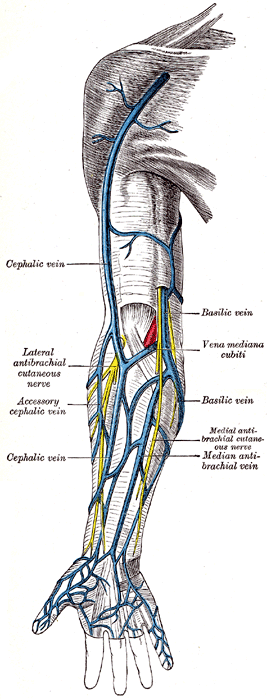Suboccipital venous plexus
Suboccipital Venous Plexus
The Suboccipital Venous Plexus is a network of veins located in the suboccipital region, which is the area at the back of the head, just below the occipital bone. This venous plexus plays a crucial role in the venous drainage of the posterior aspect of the head and neck.
Anatomy[edit | edit source]
The Suboccipital Venous Plexus is situated deep in the suboccipital triangle, a region bounded by three muscles: the Rectus capitis posterior major, the Obliquus capitis superior, and the Obliquus capitis inferior. It is closely related to the Suboccipital nerve and the Vertebral artery.
Function[edit | edit source]
The primary function of the Suboccipital Venous Plexus is to drain deoxygenated blood from the posterior part of the head and neck. It communicates with the Vertebral venous plexus and the Occipital vein, facilitating the venous return to the heart.
Clinical Significance[edit | edit source]
Due to its location and connections, the Suboccipital Venous Plexus can be involved in the spread of infections or metastases from the head and neck to the vertebral column or the brain. Understanding its anatomy is crucial in neurosurgery and radiology.
See Also[edit | edit source]
References[edit | edit source]
Search WikiMD
Ad.Tired of being Overweight? Try W8MD's physician weight loss program.
Semaglutide (Ozempic / Wegovy and Tirzepatide (Mounjaro / Zepbound) available.
Advertise on WikiMD
|
WikiMD's Wellness Encyclopedia |
| Let Food Be Thy Medicine Medicine Thy Food - Hippocrates |
Translate this page: - East Asian
中文,
日本,
한국어,
South Asian
हिन्दी,
தமிழ்,
తెలుగు,
Urdu,
ಕನ್ನಡ,
Southeast Asian
Indonesian,
Vietnamese,
Thai,
မြန်မာဘာသာ,
বাংলা
European
español,
Deutsch,
français,
Greek,
português do Brasil,
polski,
română,
русский,
Nederlands,
norsk,
svenska,
suomi,
Italian
Middle Eastern & African
عربى,
Turkish,
Persian,
Hebrew,
Afrikaans,
isiZulu,
Kiswahili,
Other
Bulgarian,
Hungarian,
Czech,
Swedish,
മലയാളം,
मराठी,
ਪੰਜਾਬੀ,
ગુજરાતી,
Portuguese,
Ukrainian
Medical Disclaimer: WikiMD is not a substitute for professional medical advice. The information on WikiMD is provided as an information resource only, may be incorrect, outdated or misleading, and is not to be used or relied on for any diagnostic or treatment purposes. Please consult your health care provider before making any healthcare decisions or for guidance about a specific medical condition. WikiMD expressly disclaims responsibility, and shall have no liability, for any damages, loss, injury, or liability whatsoever suffered as a result of your reliance on the information contained in this site. By visiting this site you agree to the foregoing terms and conditions, which may from time to time be changed or supplemented by WikiMD. If you do not agree to the foregoing terms and conditions, you should not enter or use this site. See full disclaimer.
Credits:Most images are courtesy of Wikimedia commons, and templates, categories Wikipedia, licensed under CC BY SA or similar.
Contributors: Prab R. Tumpati, MD


